by University of New South Wales – Phys.org
Imagine if one day blood transfusions from strangers were not needed because they could be produced from cells that line your own blood vessels’ cells.
While that day is still some years off, medical researchers at UNSW Sydney have made an important first step by identifying—in mice—a mechanism that is used naturally in mammals to make blood from cells that line blood vessels.
It was already known that a process termed “endothelial to hematopoietic transition” takes place in mammalian embryos, whereby cells lining blood vessels (endothelial cells) change into blood stem cells.
But the identity of the cells that regulate this process had up until now been a mystery.
In a paper published recently in the journal Nature Cell Biology, UNSW Health & Medicine’s Professor John Pimanda, Dr. Vashe Chandrakanthan and a team of researchers describe how they solved this puzzle by identifying the cells in the embryo that can convert adult endothelial cells into blood stem cells. The cells—known as “Mesp1-derived PDGFRA+ stromal cells”—reside underneath the aorta.
While more research is needed before this can be translated into clinical practice, the discovery could be an important step in regenerative medicine by providing a potential new tool to generate engraftable hematopoietic stem cells.




